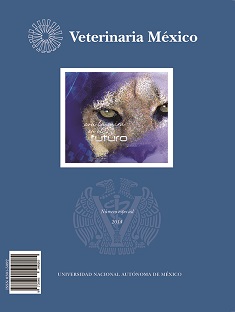Coprological and ultrasonographic study in dogs and sheep of a suburban community in the Estado de México in search of Echinococcus spp
Main Article Content
Abstract
Article Details
References
Rodríguez-Vívas RI, Cob G, Domínguez A. Frecuencia de parásitos gastrointestinales en animales domésticos diagnosticados en Yucatán, México. Rev Biomed 2001; 12:19-25.
Fernández CF, Cantó AGJ. Frecuencia de helmintos en intestinos de perros sin dueño sacrificados en la ciudad de Querétaro, Querétaro, México. Vet Méx 2002; 33:247-53.
Eguía-Aguilar P, Cruz-Reyes A, Martínez- Maya JJ. Ecological analysis and description of the intestinal helminths in dogs in Mexico City. Vet Parasitol 2005; 127:139-46.
Martínez-Maya JJ, Zúñiga AI, Jaramillo ACJ, Cárdenas LJ, Navarro FR. Caracterización epidemiológica de la equinococosis/hidatidosis en Zacatecas, México. Vet Méx 1994; 25: 231-37.
Rodríguez-Vivas RI, Gutierrez-Ruiz E, Bolio-González ME, Ruiz-Piña H, Ortega- Pacheco A, Reyes-Novelo E et al. An epidemiological study of intestinal parasites of dogs from Yucatan, Mexico, and their risk to public health. Vector Borne Zoonotic Dis 2011; 11:1141-4.
Eckert J, Gemmell MA, Meslin FX, Pawlowski ZS. WHO/OIE Manual on Echinococcosis in Humans and Animals: A Public Health Problem of Global Concern. Paris: World Organization for Animal Health, 2001.
Schantz PM. Guía para el empleo de bromhidrato de arecolina en el diagnóstico de la infección por Echinococcus granulosus en el perro. Bol Chil Parasitol 1973; 28: 81-90.
Carmona CR, Perdomo A, Carbo C, Alvarez J, Monti R, Grauert D et al. Risk factors associated with human cystic echinococcosis in Florida, Uruguay: results of a mass screening study using ultrasound and serology. Am J Trop Med Hyg 1998; 58: 599-605.
Macpherson CNL, Bartholomot B, Frider B. Application of ultrasound in diagnosis, treatment, epidemiology, public health and control of Echinococcus granulosus and E. multilocularis. Parasitology 2003; 127: S21-S35.
Lahmar S, Chéhida FB, Pétavy AF, Hammou A, Lahmar J, Ghannay A et al. Ultrasonographic screening for cystic echinococcosis in sheep in Tunisia. Vet Parasitol 2007; 143: 42-9.
Maravilla P, Thompson RCA, Palacios R, Estcourt A, Ramirez S, Mondragón C et al. Echinococcus granulosus cattle strain identification in an autochthonous case of cystic echinococcosis in central Mexico. Act Trop 2004; 92: 231-36.
Mata-Miranda P, Osnaya-Palmai I, Rodríguez-Prado U, Gutiérrez-Marín A, Tawil M, Hernández-González S et al. Epidemiologic and ultrasonographic study of echinococcosis in a community in the state of Mexico. Am J Trop Med Hyg 2007; 77: 500-03.
Serpell J. The domestic dogs. Its evolution, behavior and interactions with people. Cambridge, England: Cambridge University Press, 1995.
Orihuela TA, Solano VJ. Demographics of the owned dog population in Miacatlán, Morelos, México. Anthrozoos 1995; 8: 171-75.
Savilla TM, Joy JE, May JD, Somerville CC. Prevalence of dog intestinal nematode parasites in south central West Virginia, USA. Vet Parasitol 2011; 178: 115-20.
Joffe D, Van Niekerk D, Gagné F, Gilleard J, Kutz S, Lobingier R. The prevalence of intestinal parasites in dogs and cats in Calgary, Alberta. Can Vet J 2011; 52: 1323-28.
Mirzaei M, Fooladi M. Prevalence of intestinal helminths in owned dogs in Kerman city, Iran. Asian Pac J Trop Med 2012; 5: 735-37.
Torgerson PR, Heath DD. Transmission dynamics and control options for Echinococcus granulosus. Parasitology 2003; 127: S143-S158.
Budke MC, Campos PM, Wang Q, Torgerson PR. A canine purgation study and risk factor analysis for echinococcosis in a high endemic region of the Tibetan plateau. Vet Parasitol 2005; 127: 43-49.
License

Veterinaria México OA by Facultad de Medicina Veterinaria y Zootecnia - Universidad Nacional Autónoma de México is licensed under a Creative Commons Attribution 4.0 International Licence.
Based on a work at http://www.revistas.unam.mx
- All articles in Veterinaria México OA re published under the Creative Commons Attribution 4.0 Unported (CC-BY 4.0). With this license, authors retain copyright but allow any user to share, copy, distribute, transmit, adapt and make commercial use of the work, without needing to provide additional permission as long as appropriate attribution is made to the original author or source.
- By using this license, all Veterinaria México OAarticles meet or exceed all funder and institutional requirements for being considered Open Access.
- Authors cannot use copyrighted material within their article unless that material has also been made available under a similarly liberal license.



